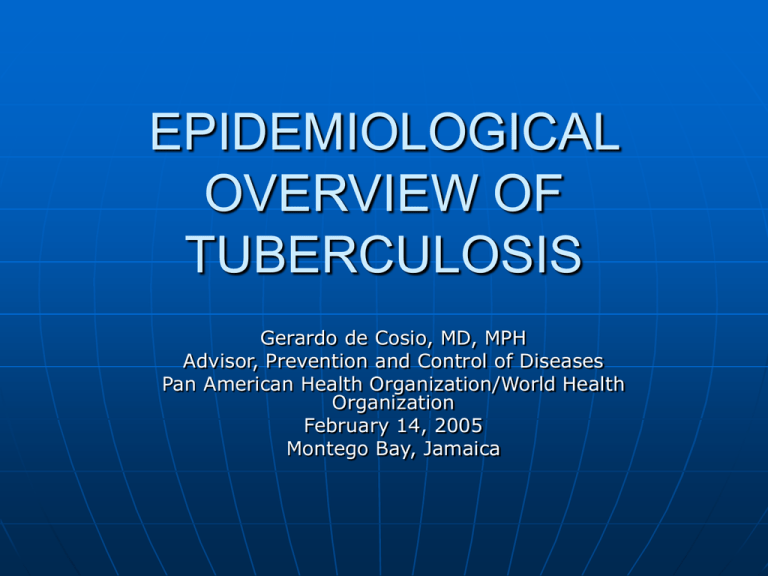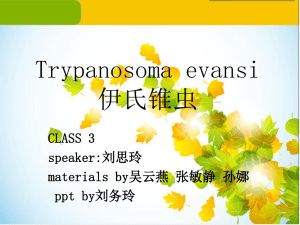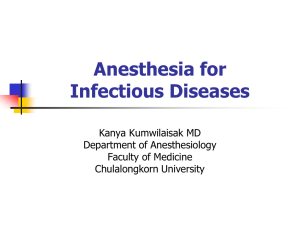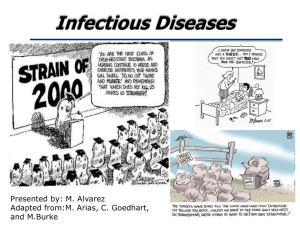
EPIDEMIOLOGICAL
OVERVIEW OF
TUBERCULOSIS
Gerardo de Cosio, MD, MPH
Advisor, Prevention and Control of Diseases
Pan American Health Organization/World Health
Organization
February 14, 2005
Montego Bay, Jamaica
Elements to Understanding TB
Control
Interventions
Agent
Individual
Community
Remember these three concepts:
1.Infectivity
2.Pathogenicity
3.Virulence
The Burden of Tuberculosis,2004
Overall, 1/3 of the world population is currently
infected with M. tuberculosis
16 million TB infected (246/100k)
(including .38 TB/HIV)
8.8 million new cases, 80% in 22 high-burden countries
(141/100K)
3.9 M New smear +
2 million deaths
98% of these deaths in the developing world
Countries: Developing -young adults/Developed - elderly
Over 1/4 million deaths due to TB/HIV
Multi-drug resistance (MDRTB) present in 102 of 109 countries
surveyed from 1994-2003
Descriptive epidemiology
More common in developing countries.
Inadequate funding
In developed countries is more frequent
among immigrants, drug users, HIV,
homeless, and those living in inner cities.
HIV alone does not explain the increase of
TB.
In developed countries more frequent in
old age (shift in age)
Descriptive Epidemiology –
Socioeconomic Status
Poverty
• Crowding living conditions
• Reduce access to health care
Race/ethnicity
Minorities
Migration
Population density (rural vs. urban)
Marital status
Substance abuse/alcoholism
Nutritional status
Descriptive epidemiology
Age-specific incidence varies over
countries and socioeconomic conditions:
• Elders in Developed countries
• Young adults in developing countries*
Higher among males than females
Access to diagnosis
Health services notification process
* Mainly those in their most productive years of life
Definitions: Patients with TB
TB infection
TB bacilli live inside the person, but the
bacilli do not cause pathological
destruction of organs
No signs or symptoms of disease
TB disease
TB bacilli progressively invade an
organ(s)
Signs and symptoms of disease appear
Definitions: Patients with TB
Pulmonary TB
Disease involves the lung parenchyma
Smear-positive: visible TB bacilli in
sputum
Smear-negative: no visible TB bacilli in
sputum
Extra-pulmonary TB
Disease involving an organ other than
the lung parenchyma
Includes pleural TB
Definitions: TB Epidemiology
Incidence
• Number of persons that develop new TB disease
within a specific time period, specific
geographic area
• Divided by number of persons at risk for TB
disease (includes persons with and without TB
infection)
Prevalence
• Number of persons that develop new TB disease
plus the number of persons that already have
disease (existing cases + “incident” cases)
• Divided by number of persons from which the
population of cases arose
Definitions: TB Epidemiology
Annual risk of infection
• Probability in a given year that a person will
develop TB infection
Notification rate
• Number of persons notified to a public health
agency per 100,000 population
• Most widely used statistic
• Not the same as the incidence rate, because
depends on persons who seek medical care,
receive TB diagnosis, have public health
report form complete, meet agency’s
definition of a case
Risk of infection and infectious
cases
Pre-chemotherapy era
1 infectious sources infected 20 persons during the
2-year period the case remained infectious before
death or spontaneous bacteriological conversion.
When intervention introduced
• Duration of infectiousness reduced
• Transmission decreased
• Relation between prevalence and incidence
disturbed.
In countries with inadequate case management, the
number of infectious patients may remain essentially
the same after 2 years, because the principal impact
of such an intervention lies with a reduction of case
fatality at the expense of keeping infectious cases
alive.
Infection increases with HIV and immunocompetent
host
Risk of Infection from Exposure
Exposure to:
• Persons who cough
• Persons with sputum positive for acid-fast
bacilli
• Persons not on TB treatment
• Persons just started on TB treatment
• Persons with a poor response to TB
treatment
Close contact, for long amounts of time,
outside of natural sunlight (e.g., UV light)
• Example: a slum dwelling with many persons
living in a small space with very little
sunlight
Definitions: TB Epidemiology
Treatment success rate
• Number of new, smear-positive TB patients
cured or completing treatment divided by all
new, smear-positive TB patients enrolled in a
DOTS program
• International goal is > 85% success rate
Case detection rate
• Number of TB patients notified in public
health surveillance divided by estimated TB
incidence
• Estimated TB incidence based on annual risk
of infection and other studies
• International goal is > 70% case detection
rate
Exposure to tubercule bacilli
Number of incident cases
Duration of infectiousness
Number of case-contact/time
• Population density
• Family size
• Difference in climatic conditions
• Age of sources of infection
• Gender
Housing characteristics
Think TB
Cough
Sputum
Haemoptysis
Fever
Loss of weight
Chest pain
Etc., etc., etc.
Steps in the pathogenesis of TB
Infectious
Exposure
Sub-clinical
Infection
Death
Non-Infectious
Infection with tubercle bacilli
Probability of infection depends on:
Number of droplets nuclei in air
Duration of exposure of a susceptible
individual to that droplet
Airborne transmission
Risk of infection is exogenous
To be transmissible through air, agent must remain buoyant
in the air.
Velocity of a droplet falling to the ground depends on:
surface and diameter.
For example: in moisture-saturated air droplets would fall
to the ground from a height of 2 mts. in less than 10 sec.
Liquid droplets tend to evaporate, diminishing their size.
The duration of time droplets remain in unsaturated air is
proportional to its size.
• Very small droplets evaporate immediately
• Large drops settle rapidly and reach ground without
evaporation.
Droplets with a size less than 0.1 mm. are more likely to
reach alveoli and then produce infection.
Droplets higher than 5 mm will not produce infection.
TB Infection
Droplet nuclei containing
mycobacteria inhaled
Usually deposited in the lower
lobes
Characteristics of an infectious patient
Patient must be able to produce airborne
infectious droplets.
It requires some 5,000 bacilli in 1 ml. of
sputum to yield positive a smear, and
10,000 to identify a smear as positive with
a 95% probability.
Patients with a positive smear are by far
more infectious than those with a negative
one and positive culture.
Probability of becoming infected varies
depending on the distance between source
and receptor.
Air circulation and ventilation
Volume of air into which the bacilli are
expelled determines the probability that a
susceptible individual becomes infected
Ventilation dilutes the concentration of
infectious droplets nuclei
Surgical masks are of low efficiency
because they do not filter particles higher
than 5 mm, and do not seal mouth and
nose.
Reduction of Infection
Reducing expulsion of infectious materials
from source cases such a covering the
mouth and nose during coughing and the
most efficient treatment.
Host immune response
• Latent TB
• Removed before infection through
macrophages.
Other modes of transmission: M. bovis
Tuberculin
Tuberculin test
• Sensitivity of test is well characterized
• Specificity unpredictable.
The influence of BCG vaccination on
the results of tuberculin skin testing
is related to the time elapsed since
vaccination.
Prevalence of infection
PPD predictive value is higher when
the prevalence of infection is higher
Population density (urban vs. rural)
Socioeconomic indicators (crowding)
Etiologic epidemiology
The risk of becoming infected is largely exogenous in
nature:
• Characteristics of the source
• Environment
• Duration of exposure
• (most likely young adults)
The risk of developing tuberculosis is largely endogenous,
determined by the integrity of the cellular immune system
most likely elders)
The importance of any risk factor in public health is
determined by both the strength of the association and the
prevalence of the risk factor in the population.
Etiologic epidemiology
Time elapsed since becoming infected (risk is
elevated in the first years following infection,
rapidly falls off and then remains low, but
measurable for a prolonged period of time.
As a rule of the thumb is that the lifetime risk of
a newly infected young child might be 10%, and
that half of this risk falls within the first 5 years
following infection (immune system).
The risk of development of disease in previously
infected persons is not equally spread over the
course of HIV infection.
Risk factors
Infection > 7 yr past or < year past
HIV
Fibrotic lesions
Silicosis
Carcinoma of head or neck
Hemophilia
Immuno uppresive treatment
Hemodialysis
Underweight
Diabetes
Gastrectomy
Jejunoileal bypass
Infecting dose
Age (adolescents and > 60)
Genetic factors
•
•
•
•
Sex (females vs. males)
Body build (low BMI, extra/pulmonary)
HLA types
Blood groups (higher in blood groups AB or B
than O or A)
• Hemophilia
• Virgin population
• Other genetic factors
Environmental
Smoking
Alcohol abuse
Injecting drug users
Nutrition
• Malnutrition
• Diet (vegetarian)
• Vitamin D defficiency
Medical conditions
Silicosis (25 times Diabetes (3 times
higher)
Malignant lymphomas (neck and head) (
Renal failure (10-15 times higher)
Measles ???
Gastrectomy (5 times higher)
Jejunoileal bypass (association reported
but unknown prevalence)
Corticosteroid treatment (controversial)
Pregnancy
No solid evidence
However, there are indications that
post-partum period might double the
risk of progression to TB
Factors associated with the etiology of the
agent
Infecting dose effect
Strain virulence associated to katG
gene
Drug resistance
Infection with M. bovis.
Re-infection
All persons who have been treated
can be re-infected
Immunologic memory wanes
Note: It has been noted that those who already have been
infected may have a lower risk of developing the disease
than those who are not.
Mortality
TB mortality risk factors
Site (higher in positive smear)
Type of disease (association to…)
Timeliness of diagnosis
•
•
•
•
•
Appropriate diagnosis
Mistake in reading X-rays
Mistake in interpreting signs and symptoms
Delayed diagnosis
Quality of treatment
Each war and economic unrest usually
results in an increase of mortality
Factors determining characteristics
of mortality
Age-specific differences in mortality
Difference in mortality in each cohort
group
Difference at particular periods or
events
Impact of HIV infection
Endogenous re-activation of persons who
became infected with HIV
Progression from infection in persons with
pre-existing HIV infection
Transmission to the general population
from persons who develop TB because of
their HIV infection
The lifetime risk of dually infected persons
to develop TB is about 30%
Higher probability of extra-pulmonary TB
The magnitude of TB mortality in the
future will not so much depend on the
epidemiology of tuberculosis as on the
ability of effective treatment








